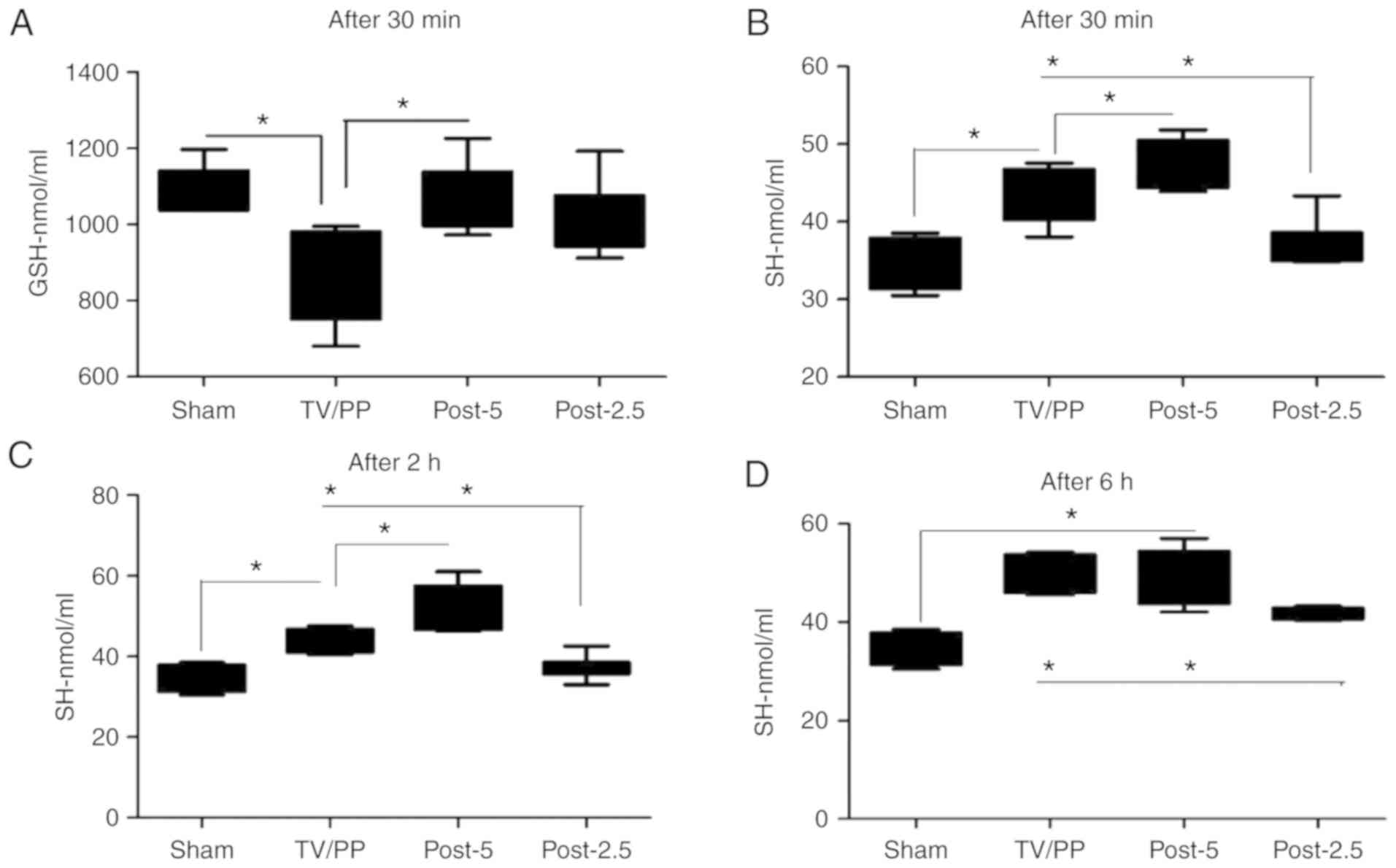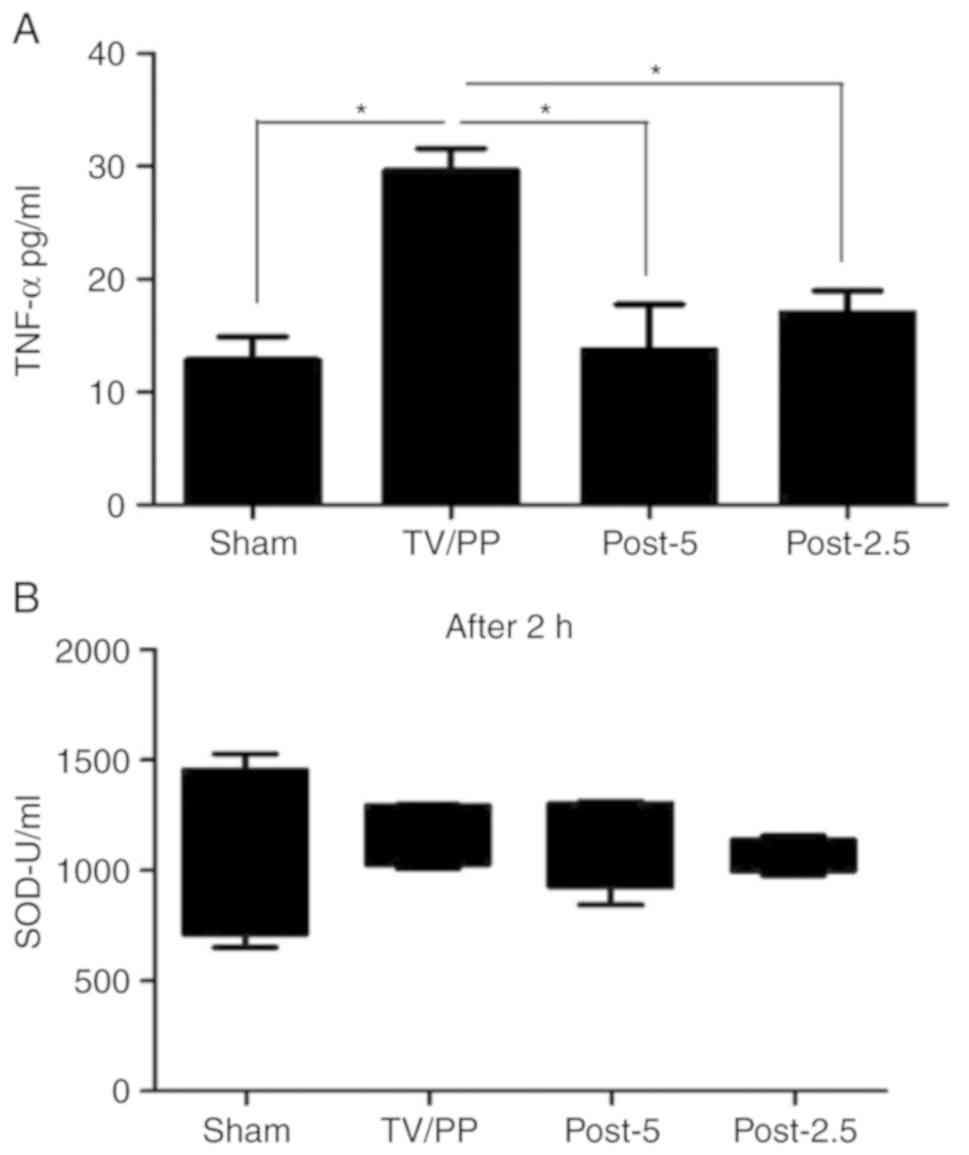|
1
|
Clarke HC: History of endoscopic and
laparoscopic surgery. World J Surg. 25:967–968. 2001.PubMed/NCBI View Article : Google Scholar
|
|
2
|
Sammour T, Mittal A, Loveday BP, Kahokehr
A, Phillips AR, Windsor JA and Hill AG: Systematic review of
oxidative stress associated with pneumoperitoneum. Br J Surg.
96:836–850. 2009.PubMed/NCBI View
Article : Google Scholar
|
|
3
|
Liu KX, Li YS, Huang WQ, Chen SQ, Wang ZX,
Liu JX and Xia Z: Immediate postconditioning during reperfusion
attenuates intestinal injury. Intensive Care Med. 35:933–942.
2009.PubMed/NCBI View Article : Google Scholar
|
|
4
|
Polat C, Yilmaz S, Serteser M, Koken T,
Kahraman A and Dilek ON: The effect of different intraabdominal
pressures on lipid peroxidation and protein oxidation status during
laparoscopic cholecystectomy. Surg Endosc. 17:1719–1722.
2003.PubMed/NCBI View Article : Google Scholar
|
|
5
|
Ates E, Yilmaz S, Ihtiyar E, Yasar B and
Karahuseyinoglu E: Preconditioning-like amelioration of
erythropoietin against laparoscopy-induced oxidative injury. Surg
Endosc. 20:815–819. 2006.PubMed/NCBI View Article : Google Scholar
|
|
6
|
Hatipoglu S, Akbulut S, Hatipoglu F and
Abdullayev R: Effect of laparoscopic abdominal surgery on
splanchnic circulation: Historical developments. World J
Gastroenterol. 20:18165–18176. 2014.PubMed/NCBI View Article : Google Scholar
|
|
7
|
Veres TG, Petrovics L, Sárvári K,
Vereczkei A, Jancsó G, Farkas KB and Takács I: The effect of
laparoscopic pre- and postconditioning on pneumoperitoneum induced
injury of peritoneum. Clin Hemorheol Microcirc, May 27, 2019 (Epub
ahead of print).
|
|
8
|
Loubele ST, ten Cate H and Spronk HM:
Anticoagulant therapy in critical organ ischaemia/reperfusion
injury. Thromb Haemost. 104:136–142. 2010.PubMed/NCBI View Article : Google Scholar
|
|
9
|
Lipton P: Ischemic cell death in brain
neurons. Physiol Rev. 79:1431–1568. 1999.PubMed/NCBI View Article : Google Scholar
|
|
10
|
Oksuz H, Bulbuloglu E, Senoglu N, Ciralik
H, Yuzbasioglu MF, Kilinc M, Dogan Z, Goksu M, Yildiz H, Ozkan OV
and Atli Y: Re-protective effects of pre- and post-laparoscopy
conditioning, zinc, pentoxifylline, and N-acetylcysteine in an
animal model of laparoscopy-induced ischemia/reperfusion injury of
the kidney. Ren Fail. 31:297–302. 2009.PubMed/NCBI View Article : Google Scholar
|
|
11
|
Yilmaz S, Ates E, Polat C, Koken T, Tokyol
C, Akbulut G and Gokce O: Ischemic preconditioning decreases
laparoscopy-induced oxidative stress in small intestine.
Hepatogastroenterology. 50:979–982. 2003.PubMed/NCBI
|
|
12
|
Yilmaz S, Koken T, Tokyol C, Kahraman A,
Akbulut G, Serteser M, Polat C, Gokce C and Gokce O: Can
preconditioning reduce laparoscopy-induced tissue injury? Surg
Endosc. 17:819–824. 2003.PubMed/NCBI View Article : Google Scholar
|
|
13
|
Zhao ZQ, Corvera JS, Halkos ME, Kerendi F,
Wang NP, Guyton RA and Vinten-Johansen J: Inhibition of myocardial
injury by ischemic postconditioning during reperfusion: Comparison
with ischemic preconditioning. Am J Physiol Heart Circ Physiol.
285:H579–H588. 2003.PubMed/NCBI View Article : Google Scholar
|
|
14
|
Jávor S, Shanava K, Hocsák E, Kürthy M,
Lantos J, Borsiczky B, Takács I, Horváth S, Balatonyi B, Ferencz S,
et al: Preconditioning is a method that may reduce the negative
side-effect of pneumoperitoneum. Interv Med Appl Sci. 2:115–120.
2010.
|
|
15
|
Placer ZA, Cushman LL and Johnson BC:
Estimation of product of lipid peroxidation (malonyl dialdehyde) in
biochemical systems. Anal Biochem. 16:359–364. 1966.PubMed/NCBI View Article : Google Scholar
|
|
16
|
Sedlak J and Lindsay RH: Estimation of
total, protein-bound, and nonprotein sulfhydryl groups in tissue
with Ellman's reagent. Anal Biochem. 25:192–205. 1968.PubMed/NCBI View Article : Google Scholar
|
|
17
|
Misra HP and Fridovich I: The role of
superoxide anion in the autoxidation of epinephrine and a simple
assay for superoxide dismutase. J Biol Chem. 247:3170–3175.
1972.PubMed/NCBI
|
|
18
|
Ott DE: The peritoneum and the
pneumoperitoneum: A review to improve clinical outcome. Gynecol
Surg. 1:101–106. 2004.
|
|
19
|
Lee JY and Choi SH: Evaluation of total
oxidant and antioxidant status in dogs under different CO2
pneumoperitoneum conditions. Acta Vet Scand. 57(23)2015.PubMed/NCBI View Article : Google Scholar
|
|
20
|
Ypsilantis P, Lambropoulou M, Tentes I,
Chryssidou M, Georgantas T and Simopoulos C: Room air versus carbon
dioxide pneumoperitoneum: Effects on oxidative state, apoptosis and
histology of splanchnic organs. Surg Endosc. 30:1388–1395.
2016.PubMed/NCBI View Article : Google Scholar
|
|
21
|
Thuret R, Saint Yves T, Tillou X,
Chatauret N, Thuillier R, Barrou B and Billault C: Ischemic pre-
and post-conditioning: Current clinical applications. Prog Urol. 24
(Suppl 1):S56–S61. 2014.PubMed/NCBI View Article : Google Scholar
|
|
22
|
Trunzo JA, McGee MF, Cavazzola LT,
Schomisch S, Nikfarjam M, Bailey J, Mishra T, Poulose BK, Lee YJ,
Ponsky JL and Marks JM: Peritoneal inflammatory response of natural
orifice translumenal endoscopic surgery (NOTES) versus laparoscopy
with carbon dioxide and air pneumoperitoneum. Surg Endosc.
24:1727–1736. 2010.PubMed/NCBI View Article : Google Scholar
|
|
23
|
Bingener J, Krishnegowda NK and Michalek
JE: Immunologic parameters during NOTES compared with laparoscopy
in a randomized blinded porcine trial. Surg Endosc. 23:178–181.
2009.PubMed/NCBI View Article : Google Scholar
|
|
24
|
Berguer R, Cornelius T and Dalton M: The
optimum pneumoperitoneum pressure for laparoscopic surgery in the
rat model. A detailed cardiorespiratory study. Surg Endosc.
11:915–918. 1997.PubMed/NCBI View Article : Google Scholar
|
|
25
|
Al-Saeedi M, Nickkholgh A, Schultze D,
Flechtenmacher C, Zorn M, Liang R, Gutt CN and Schemmer P: Glycine
protects the liver from reperfusion injury following
pneumoperitoneum. Eur Surg Res. 59:91–99. 2018.PubMed/NCBI View Article : Google Scholar
|
|
26
|
Mateos R, Lecumberri E, Ramos S, Goya L
and Bravo L: Determination of malondialdehyde (MDA) by
high-performance liquid chromatography in serum and liver as a
biomarker for oxidative stress. Application to a rat model for
hypercholesterolemia and evaluation of the effect of diets rich in
phenolic antioxidants from fruits. J Chromatogr B Analyt Technol
Biomed Life Sci. 827:76–82. 2005.PubMed/NCBI View Article : Google Scholar
|
|
27
|
Kolagal V, Karanam SA, Dharmavarapu PK,
D'Souza R, Upadhya S, Kumar V, Kedage V, Muttigi MS, Shetty JK and
Prakash M: Determination of oxidative stress markers and their
importance in early diagnosis of uremia-related complications.
Indian J Nephrol. 19:8–12. 2009.PubMed/NCBI View Article : Google Scholar
|
|
28
|
Sack M: Tumor necrosis factor-alpha in
cardiovascular biology and the potential role for anti-tumor
necrosis factor-alpha therapy in heart disease. Pharmacol Ther.
94:123–135. 2002.PubMed/NCBI View Article : Google Scholar
|













